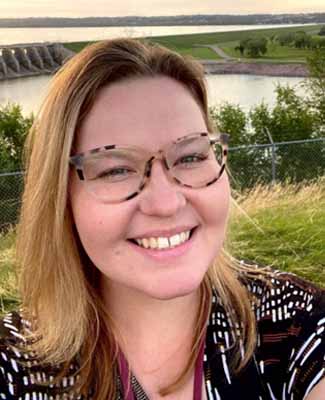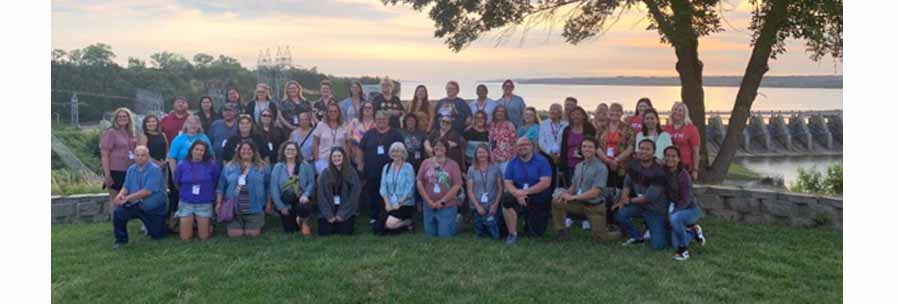Kristine Knottnerus
Special Education, Douglas Middle School, Box Elder

Kristine Knottnerus is a special education teacher at Douglas Middle School in Box Elder, S.D. Kristine took part in the South Dakota History Road Trip, a Department of Education-sponsored event designed to take a deep dive into the people, places, and events that influenced South Dakota history. The DOE caught up with her recently to ask her a few questions before the school year starts.
How long have you been teaching?
This will be my sixth year, my second in the Rapid City area. I moved to South Dakota from Chicago two years ago.
What made you decide to go into teaching?
I think I’ve always had a bend towards teaching. When I was younger, I had younger siblings that I would help with reading and math. As I got older, when I was in college, I realized that I loved the process of teaching. Teaching is a very sequential process. As students learn concepts, the things they learn build upon each other. It’s very rewarding to see their confidence develop as they see success. I love seeing their confidence grow as they realize they can do something that a week or two ago they thought was just too much for them.
What’s the best part of teaching?
It’s wonderful to be able to develop relationships with students. Being a part of their lives for just a time. Having them move on is hard, but it’s so rewarding at the same time. I love being a safe place, where a student knows they can make mistakes, and that they can grow from that. At the beginning, students are not sure how you’re going to react when they mess up. But after some time, I can build that trust, and they can take a chance because they know I’m going to be there for them.
What’s the most challenging part of teaching?
Sometimes students need a little extra help in some areas, and it can feel like there isn’t enough time. There’s a lot of things we need to fit into a day. If the majority of students are moving on, it can be hard to circle back and help the one or two who are still struggling with that topic.
If you could go back in time and give yourself some advice at the start of your career, what would that advice be?
To trust the process. When you’re starting out teaching, you want to be perfect. You want to be the best, but there are challenges every year. There’s a lot of learning that teachers do throughout the process. Sometimes you have to do something imperfectly first so that you can get better and better as you go along.
You went on the DOE’s East River History Road Trip. What was your favorite place that you visited?
My favorite place was the Mitchell Prehistoric Indian Village. It was very cool to see the archeology department at work there. It was fascinating to me.
How do you think you’ll integrate that experience into your classroom?
Since the trip, I feel much more prepared to introduce state history into the classroom. I’m new to South Dakota, so it was really beneficial to be able to visit those places.
We were given a documentary about the Prehistoric Indian Village, and resources that went along with it. I’d like to use that to be able to introduce students to the concept that we have archeology here in South Dakota. There are many other sites that are important to the history of the state that we saw as well.
Do you have any, “it’s weird but it works” teaching strategies?
For reluctant learners, anything that can be gamified helps. Some kids who have a hard time even entering into conversation or being willing to read, they’re always willing to try a little bit more when it’s in game form.
What kinds of games to you play?
I have a lot of reading-specific games. I have students who develop an attitude that they can’t read next to their peers. They feel very self-conscious. I can have a student who is not willing to even say anything, but if I bring out a game, you see a completely different student. When I was working as a reading specialist in Chicago, I had kids who loved the game Uno, but hated to read. We would play five cards each, and then we’re going to read a sentence. It changed their attitude from, “I’m not going to do this,” to them being willing to try it.
You said you were a reading specialist in Chicago. Can you talk about that?
I worked with high-needs students in the city, where there was a huge need for intervention. It was reading remediation. Students are not necessarily learning how to read at the rate that they should be – that’s where I come in. [Being poor readers] affects their confidence at school, and it affects their ability to have a choice in what they want to do as they continue to grow. That’s my passion as a teacher. My goal is to, whatever students I work with, identify their own strengths and what they bring to the table. I try to identify their strengths and help them learn how to contribute in whatever circle they’re in.

Kristine Knottnerus, in the back row 5th from left, took part in the South Dakota History Road Trip this summer.
She is pictured here with her fellow travelers at Gavin's Point Dam in Yankton.
